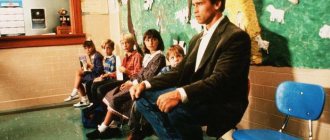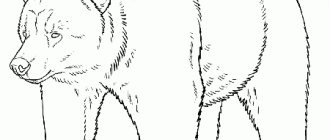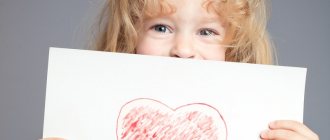Summary of an open lesson on speech development in the middle group “Wild and Domestic Animals”
Summary of an open lesson on speech development in the middle group “Wild and Domestic Animals”
Summary of an open lesson on speech development in the middle group “Wild and Domestic Animals”
Goal: Formation of cognitive and speech activity in children.
Tasks:
— consolidate children’s knowledge about the distinctive features of domestic and wild animals
;
- consolidate children’s knowledge in naming baby animals
;
— develop attention
, thinking and imagination, speech activity;
- cultivate a caring attitude towards nature and its inhabitants.
— activate children’s vocabulary, clarify the names of animals
. Where do they live?
- strengthen the ability to use in speech
nouns denoting
animals
.
— develop attention
, memory, ability to clearly pronounce words and sentences.
Educational:
— consolidation of knowledge about domestic and wild animals
.
- developing in children an idea of the diversity of the animal world
.
— develop
Creative skills.
Educational:
- cultivate interest in family
,
wild animals
.
Integration: Cognition, communication, socialization.
Preliminary work:
Looking at pictures of animals
, illustrations (
wild animals in the forest
,
pets in the village
,
animals with cubs
, a dog in a kennel, a squirrel in a hollow, a bear in a den, etc., reading stories (B. Zhidkov
“Evening”
,
“Brave Duckling”
,
“ Stray Cat”
, V. Bianki
“Mouse Peak”
, fairy tales (Russian folk tales
“The Wolf and the Seven Little Goats”
,
“Swan Geese”
,
“Crane and Heron”
,
“The Fox and the Hare”
, etc.,
“The Three Little Pigs”
S. V. Mikhalkova,
“The Ugly Duckling”
by H. H. Andersen, asking riddles Not an animal, not a bird, but afraid of everyone, catching flies and splashing into the water
(frog)
, etc., looking at
animal
.
Didactic games: “ Wild and domestic animals ”
.
"The Fourth Wheel"
.
Round dance games: “At the bear in the forest”
.
"We are walking through the forest"
.
Material:
Interactive whiteboard, pictures of wild and domestic animals
.
Contents of organized educational activities for children
1. Organizational moment
guests came to our lesson today
, let's say hello to them.
Music sounds ( animal )
.
- children, whose voices are these? (horse, cow, cat, elephant)
.
— how can you call them in one word? ( animals )
- what animals
?
( wild and domestic )
Today we will remember domestic
,
wild animals and their young
, where they live.
— Tell me, what is the difference between domestic animals and wild ones
?
(Place of residence, obtaining food)
.
(Children's answers)
.
Educator - Children today I invite you to the wonderful world of animals
. You are ready to go on a journey. Well, let's begin then!
Summary of educational activities for speech development in the senior group “Wild Animals of Russia”
Program objectives: 1. Continue to introduce children to the wild animals of our country 2. Clarify the body parts of animals 3. Develop the ability to form complex adjectives 4. Develop the ability to name words with the same root 5. Practice naming an animal in combination with the word “many” 6. Cultivate careful attitude towards animals
Lesson progress:
Org.
moment. On the easel there are pictures of wild animals of Russia.
Educator: Guys, look at the pictures, who do you see? Children: Fox, wolf, bear, hare, moose, hedgehog, squirrel, wild boar, badger. Educator: That's right, guys, who is this? How can they all be called in one word? Children: Animals Educator: You are right, these are animals. Tell me where do these animals live? Children: In the forest Educator: So what are they like? Children: Wild Educator: Yes, these are wild animals. They live on the territory of our country. These are wild animals of Russia. Let's imitate them a little and perform articulatory gymnastics. Articulation gymnastics 1. “Squirrel” (the mouth is closed, the thin tongue pushes first in one direction, then the other, resting on the cheeks) 2. “Bunny” (the upper lip is pulled up so that the upper teeth are visible. The lower lip is pressed to the lower teeth. Hold for 10 seconds) Educator: Guys, you and I have different moods: both good and bad. Do you think it can change in animals? Children offer answer options Educator: Let's do the exercise Exercise “Animals” Using facial expressions they depict how the wolf is angry, the hare is shaking with fear, the squirrel is worried, the fox is happy. Educator: Do you like animals? Children: Yes Educator: Call them affectionately Game “Call them affectionately” (hedgehog - hedgehog, squirrel - squirrel, hare - bunny, etc.) Educator: Well done! I want to tell you a little about the hedgehog. A hedgehog is a wild animal that lives in the forest. It has prickly needles on its back. When he is afraid, he curls up into a ball. He is a predator and eats mice. It happens that people take a hedgehog home and feed it milk. Although the hedgehog is small, it walks noisily. Let's stomp along with the hedgehog. Finger gymnastics “Hedgehog” On a dry forest path - alternately hitting fist on fist and palm on palm.
Top - top - top - stomp your feet.
They tap their fists on the table one by one.
A gray hedgehog, covered in needles, walks and wanders along the paths.
They hit fist against fist and palm against palm.
Looking for berries and mushrooms for their son and daughter.
alternately connect the fingertips of both hands with the thumb Educator: Now, stand on your feet, imagine that we are wild animals Physical exercise “Wild Animals”
On a hot day, along a forest path, the animals went to a watering hole.
(Children walk in a circle, one after another)
A moose calf stomped behind the mother elk,
(They walk, stomping loudly)
A little fox crept behind the mother fox,
(They walk stealthily)
A hedgehog rolled behind the mother hedgehog,
(They move in a deep squat)
Behind the mother bear a bear cub was walking,
(They move in a deep squat)
The squirrel cubs were galloping after the mother squirrel,
(They were jumping on their toes, with their arms bent in front of the chest)
Behind the mother-hare were slanting hares,
(They were jumping, making “ears” from their palms)
The she-wolf led the wolf cubs.
(Walk on all fours)
All mothers and children want to get drunk.
(They walk on all fours) Educator: Excellent. Do you know that two words can be made into one? Shall we try? Children: Yes Game “Name a new word” (a bear has thick paws - a bear is thick-footed, a hare has long ears - a hare is long-eared, a wolf has sharp teeth - a wolf is sharp-toothed, etc.) Educator: Look at the pictures, what parts of the body does the wolf have? animals? 1 child:
the wolf has a head, muzzle, fangs, teeth, nose, eyes, ears, paws, tail, mouth, claws, torso, neck
2 child:
the bear has a head, muzzle, teeth, nose, eyes, ears, paws , tail, mouth, claws, torso, neck
Educator: We have wild animals depicted on our easel. A lot of them. Game “One - many” (one fox - many foxes, one hare - many hares, one hedgehog - many hedgehogs.) Educator: Well done, guys. Someone is knocking on our door. The postman enters.
Hello, guys, I was told to give you a parcel from the squirrel.
Delivers the parcel. Educator: Guys, what is there? They open the package, there are nuts and a note “Bon appetit! Sincerely, squirrel"
We recommend watching:
Notes for a lesson on speech development in the senior group: Special-purpose transport Notes for educational activities on the formation of a holistic picture of the world in children in the middle group with visual impairments. Di Summary of a lesson on speech development for children in the senior group of preschool educational institutions. Summary of a lesson on speech development in the senior group. Nosov "Gardeners"
Similar articles:
Summary of a lesson on speech development in the senior group. Compiling a descriptive story based on a painting
Summary of a lesson on speech development in the senior group. Reading works of fiction
Summary of a lesson on speech development in the senior group. Retelling of a work of art. Charushin "Sparrow"
Summary of a lesson on ecology in the senior group of kindergarten on the topic “Man and Nature”
Lesson on emotional development in the senior group





